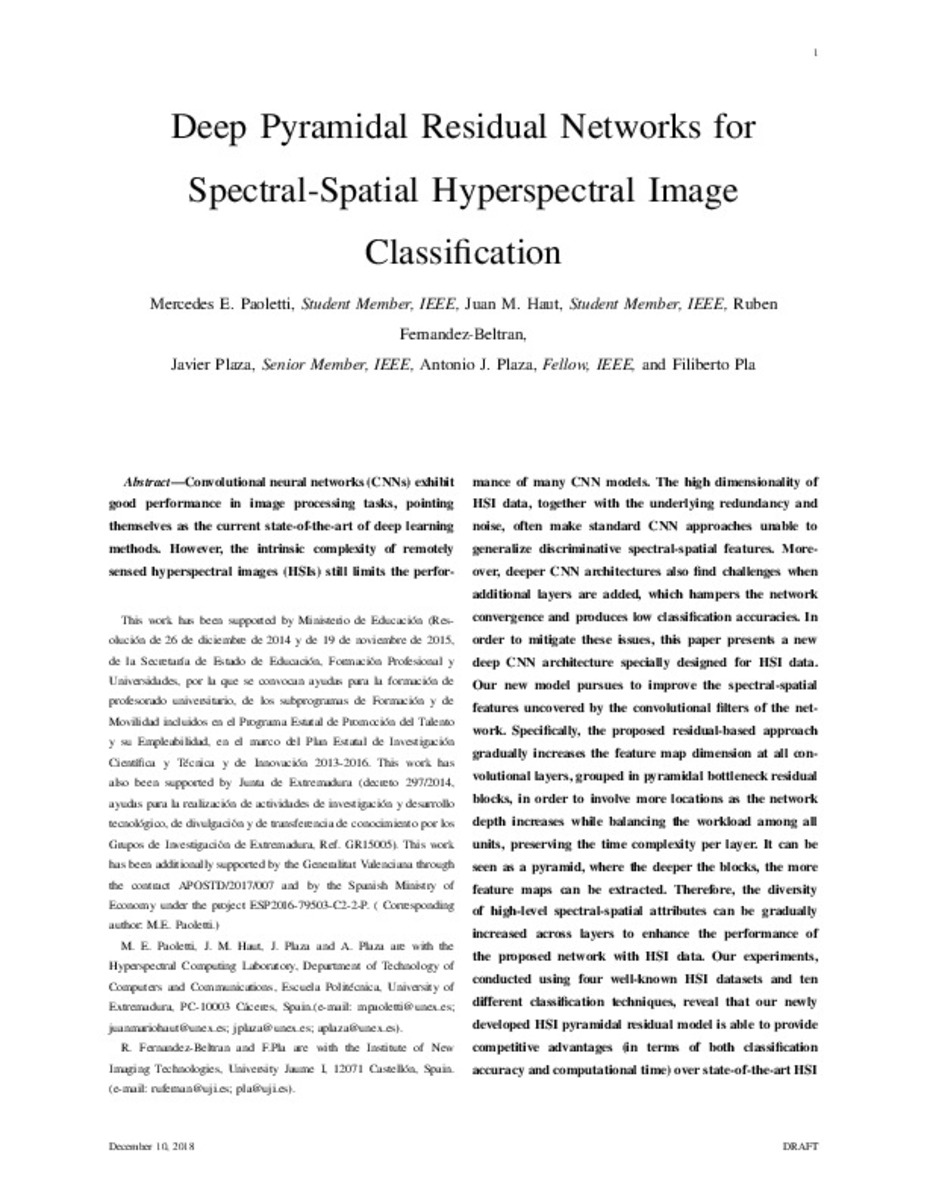Mostrar el registro sencillo del ítem
Deep Pyramidal Residual Networks for Spectral-Spatial Hyperspectral Image Classification
| dc.contributor.author | Paoletti, Mercedes Eugenia | |
| dc.contributor.author | Haut, Juan M. | |
| dc.contributor.author | Fernandez-Beltran, Ruben | |
| dc.contributor.author | Plaza, Javier | |
| dc.contributor.author | Plaza, Antonio | |
| dc.contributor.author | Pla, Filiberto | |
| dc.date.accessioned | 2018-12-11T08:51:17Z | |
| dc.date.available | 2018-12-11T08:51:17Z | |
| dc.date.issued | 2018-08 | |
| dc.identifier.citation | PAOLETTI, Mercedes E., et al. Deep pyramidal residual networks for spectral-spatial hyperspectral image classification. IEEE Transactions on Geoscience and Remote Sensing, 2018, 99: 1-15. | ca_CA |
| dc.identifier.uri | http://hdl.handle.net/10234/177995 | |
| dc.description.abstract | Convolutional neural networks (CNNs) exhibit good performance in image processing tasks, pointing themselves as the current state-of-the-art of deep learning methods. However, the intrinsic complexity of remotely sensed hyperspectral images still limits the performance of many CNN models. The high dimensionality of the HSI data, together with the underlying redundancy and noise, often makes the standard CNN approaches unable to generalize discriminative spectral-spatial features. Moreover, deeper CNN architectures also find challenges when additional layers are added, which hampers the network convergence and produces low classification accuracies. In order to mitigate these issues, this paper presents a new deep CNN architecture specially designed for the HSI data. Our new model pursues to improve the spectral-spatial features uncovered by the convolutional filters of the network. Specifically, the proposed residual-based approach gradually increases the feature map dimension at all convolutional layers, grouped in pyramidal bottleneck residual blocks, in order to involve more locations as the network depth increases while balancing the workload among all units, preserving the time complexity per layer. It can be seen as a pyramid, where the deeper the blocks, the more feature maps can be extracted. Therefore, the diversity of high-level spectral-spatial attributes can be gradually increased across layers to enhance the performance of the proposed network with the HSI data. Our experiments, conducted using four well-known HSI data sets and 10 different classification techniques, reveal that our newly developed HSI pyramidal residual model is able to provide competitive advantages (in terms of both classification accuracy and computational time) over the state-of-the-art HSI classification methods. | ca_CA |
| dc.format.extent | 16 p. | ca_CA |
| dc.format.mimetype | application/pdf | ca_CA |
| dc.language.iso | eng | ca_CA |
| dc.publisher | IEEE | ca_CA |
| dc.rights | © 2018 IEEE. Personal use is permitted, but republication/redistribution requires IEEE permission. See http://www.ieee.org/publications_standards/publications/rights/index.html for more information. | ca_CA |
| dc.rights.uri | http://rightsstatements.org/vocab/InC/1.0/ | * |
| dc.subject | convolutional neural networks (CNNs) | ca_CA |
| dc.subject | hyperspectral imaging (HSI) | ca_CA |
| dc.subject | residual networks (ResNets) | ca_CA |
| dc.title | Deep Pyramidal Residual Networks for Spectral-Spatial Hyperspectral Image Classification | ca_CA |
| dc.type | info:eu-repo/semantics/article | ca_CA |
| dc.identifier.doi | http://dx.doi.org/10.1109/TGRS.2018.2860125 | |
| dc.relation.projectID | Junta de Extremadura (GR15005) ; Generalitat Valenciana (APOSTD/2017/007) ; Spanish Ministry of Economy (project ESP2016-79503-C2-2-P) | ca_CA |
| dc.rights.accessRights | info:eu-repo/semantics/openAccess | ca_CA |
| dc.relation.publisherVersion | https://ieeexplore.ieee.org/abstract/document/8445697 | ca_CA |
| dc.contributor.funder | Ministerio de Educación, Spain (Plan Estatal de Investigación Científica y Técnica y de Innovación 2013-2016) | ca_CA |
| dc.type.version | info:eu-repo/semantics/submittedVersion | ca_CA |
Ficheros en el ítem
Este ítem aparece en la(s) siguiente(s) colección(ones)
-
INIT_Articles [743]







